Related Research Articles
As a densely populated country in a central location in Central-Southeastern Europe and with a developed economy, Romania has a dense and modern transportation infrastructure.

Galați is the capital city of Galați County, in the historical region of Moldavia, eastern Romania. Galați is a port town on the Danube River. In 2011, the Romanian census recorded 249,432 residents, making it the 8th most populous city in Romania. Galați is an economic centre based around the port of Galați, the naval shipyard, and the largest steel mill in Romania, Galați steel works.
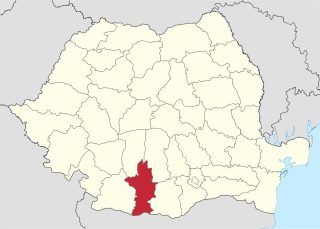
Olt County is a county (județ) of Romania on the border with Bulgaria, in the historical regions of Oltenia and Muntenia. The capital city is Slatina.
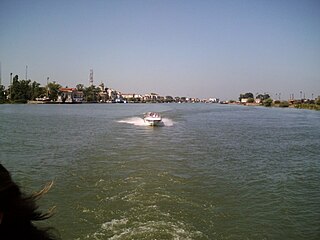
Sulina is a town and free port in Tulcea County, Romania, at the mouth of the Sulina branch of the Danube. It is the easternmost point of Romania.
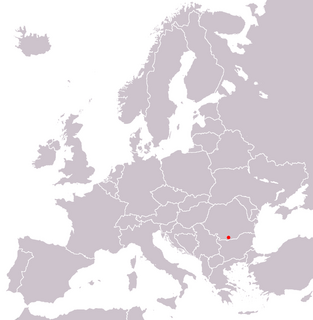
Corabia is a small Danube port located in Olt County, Romania, which used to be part of the now-dissolved Romanaţi County before World War II. Across the Danube from Corabia lies the Bulgarian village of Gigen.

The Romanian War of Independence is the name used in Romanian historiography to refer to the Russo-Turkish War (1877–78), following which Romania, fighting on the Russian side, gained independence from the Ottoman Empire. On April 16 [O.S. April 4] 1877, Romania and the Russian Empire signed a treaty at Bucharest under which Russian troops were allowed to pass through Romanian territory, with the condition that Russia respected the integrity of Romania. Consequently, the mobilization of the Romanian troops also began, and about 120,000 soldiers were massed in the south of the country to defend against an eventual attack of the Ottoman forces from south of the Danube. On April 24 [O.S. April 12] 1877, Russia declared war on the Ottoman Empire and its troops entered Romania through the newly built Eiffel Bridge, on their way to the Ottoman Empire. Due to great losses, the Russian Empire asked Romania to intervene. On July 24 [O.S. July 12] 1877, the first Romanian Army units crossed the Danube and join forces with the Russian Army.

Gigen is a village in northern Bulgaria, part of Gulyantsi Municipality, Pleven Province. It is located near the Danube River, close to the place where the Iskar River empties into it, opposite the Romanian town of Corabia.

Sucidava is a Dacian and Daco-Roman historical site, situated in Corabia, Romania, on the north bank of the Danube. The first Christian Basilica established in Romania can be found there and the foot of a Roman bridge over the Danube built by Constantine the Great to link Sucidava with Oescus. There is also a secret underground fountain which flows under the walls of the town to a water spring situated outside.
The Pârâul de Câmpie is a right tributary of the river Mureș in Transylvania, Romania. It discharges into the Mureș in Luduș. Its length is 59 km (37 mi) and its basin size is 643 km2 (248 sq mi).
Danube 21 Euroregion is a Euroregion located in Romania, Bulgaria and Serbia. The administrative center is Craiova.

Constantine's Bridge was a Roman bridge over the Danube. It was completed or rebuilt in 328 AD and remained in use for no more than four decades.

The Danube is Europe's second longest river, after the Volga. It is located in Central and Eastern Europe.
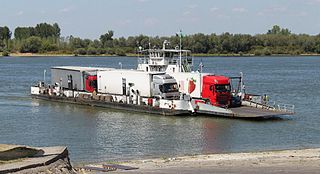
The Port of Calafat is one of the largest Romanian river ports, located in the city of Calafat on the Danube River.
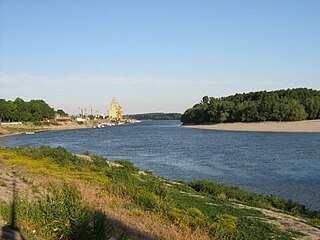
The Port of Cǎlǎrași is one of the largest Romanian river ports, located in the city of Călăraşi on the Danube River.
The Port of Orșova is one of the largest Romanian river ports, located in the city of Orşova on the Danube River.
The Port of Oltenița is one of the largest Romanian river ports, located in the city of Oltenița on the Danube River.

Acidava (Acidaua) was a Dacian and later Roman fortress on the Olt river near the lower Danube. The settlements remains are located in today's Enoşeşti, Olt County, Romania.
The Port of Moldova Veche is one of the largest Romanian river ports, located in the town of Moldova Nouă on the Danube River. The port has 6 berths with a total quay length of 560 metres (1,840 ft) and two terminals, one for cargo and one passenger terminal. Located on the Danube's left bank, it straddles kilometers 1047 through 1050 of the river's course. It is mainly used for handling wood products, sand and gravel, bricks and fertilizers.
Corabia Solar Park, a large thin-film photovoltaic (PV) power system, is built on a 45 ha plot of land near the Corabia commune in Romania. Located in the southern part of the country, 5,5 km from the Danube. Corabia Photovoltaic Park is the fifth MW solar park constructed by Renovatio. The solar park is a 7-megawatt solar power system using a number of 28,602 solar pannels of 245 Wp each of state-of-the-art thin film technology, and was completed in December 2012. The solar park is expected to supply 8,500 MWh of electricity per year. Construction began in March 2012 and was completed in December 2012.
References
- ↑ "Port Corabia" (in Romanian). danube-ports.ro. Retrieved 2009-10-20.
| This article related to ports, harbors or marinas is a stub. You can help Wikipedia by expanding it. |
